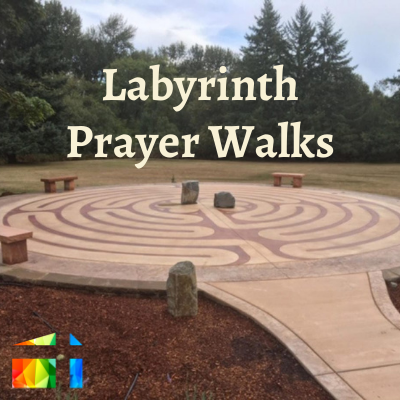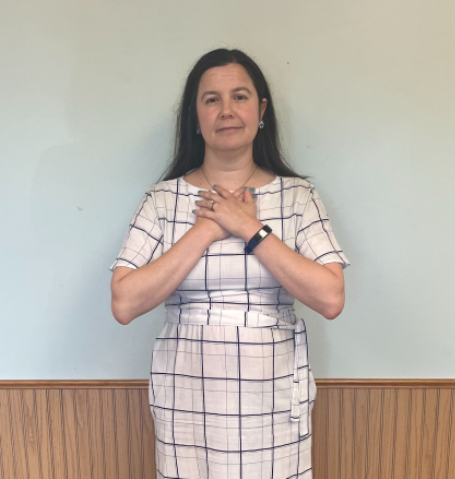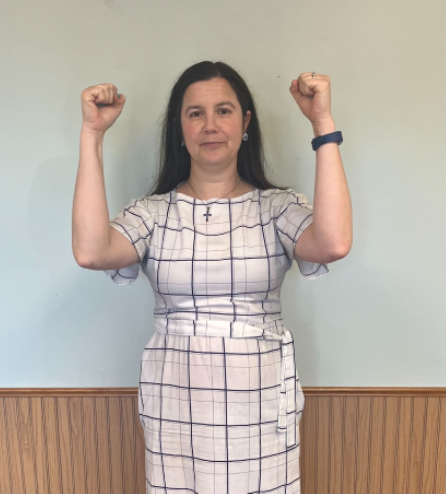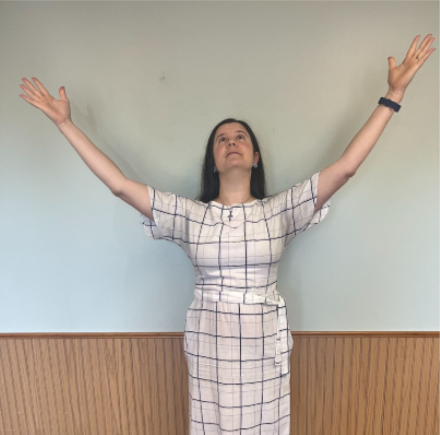Walking Meditation
This physical prayer invites you to pray as you walk, using your senses of sight, sound, and smell to be aware of God’s presence, as well as your whole body movement and voice to pray to God.
- Step 1: Find a quiet place to walk — neighborhood, park, or hiking trail.
- Step 2: Be aware of your body, your muscles, your feet, your breathing.
- Step 3: Walk at a comfortable pace and take in creation using all senses.
- Step 4: Pray silently, out loud, or in song as you seek God.

Walking a Prayer Labyrinth
A labyrinth is a simple circular path that guides silent prayer — praying while walking is a great way to bring stillness to your mind and heart. There is no right way to pray a labyrinth. Praying in whatever way helps you connect with God is the right way and serves as the best guide possible.
There are several outdoor prayer labyrinths around town:
- Wesley Chapel Cemetery, 3225 Dublin Rd, Hilliard.
- First Community Church, North Campus, 3777 Dublin Rd.
- Behind some apartment buildings in Hilliard, west of Cosgray, south of Parkmeadow Lane.
- Chadwick Arboretum on Ohio State’s campus, 2001 Fyffe Court, 43210.
- Gantz Park, 2255 Home Rd, Grove City 43123.
Here are some suggestions for your walk.
Three Stages of Walking
- Release: First try to quiet your mind and heart with a few deep, centering breaths. As you enter the labyrinth and walk the single path toward the center (there are no dead ends or false passages), pray for an open mind and heart. With kindness toward yourself, gently try to release distracting thoughts and let go of expectations or whatever’s on your mind.
- Receive: Once you arrive at the center, listen for God’s message to you today. Stay in the center as long as you like, receiving the love and word of God for you.
- Return: As you retrace your steps out, give thanks for God’s presence and message.
Other Ideas to Focus your Walk
- Give gracious attention to God. Let all thoughts go when they present themselves in your awareness. Be attentive to your breath and your intention to be present with God in these moments.
- Ask a question. Focus on a question that you have been asking yourself.
- Read Scripture. Focus on one or more ideas or phrases from a scripture passage.
- Ask for help through prayer. You might also simply pray throughout the labyrinth walk. You might want to talk to God as if you were writing a letter, pouring out your heart, expressing anger, experiencing joy or gratitude, asking for what you need.
- Sing or chant silently to yourself a line from a hymn or song that’s meaningful to you.
- Repeat a key word or phrase as you walk. It can be something short like “Abba,” which means “daddy” in Aramaic, or “God loves me… no matter what.” Other examples:
- Abide in my Love.
- Lord, as You will,
Lord, as You know,
Have mercy. - Speak through the earthquake, the wind, and the fire, still small voice of Love. (1 Kings 19:11-12)
- Be still and know that I am God. (Psalm 46:10)
- I am with you always, even to the end of the age. (Matthew 28:20b)
I Am Here Prayer
This simple practice connects words and gestures to allow us to engage our bodies in the present moment. This can be a great practice to help ground us before doing another practice that requires more concentration and presence.
There are 4 gestures:
(1) CRADLE – imagine you are holding a precious baby.
(2) HANDS ON HEART


(3) STRENGTH – use your muscles
(4) HANDS WIDE


Practice flowing through the gestures until you are comfortable.
Then, add the words:
I
AM
HERE.
Start with one word per gesture.
- “I” in the cradle gesture.
- “Am” in the hands-on-heart gesture.
- “Here” in the strength gesture.
Then start repeating the words while continuing through the gestures.
- “I” in the hands-wide gesture.
- “Am” in the cradle gesture.
- “Here” in the hands-on-heart gesture.
Continue several times until you’ve repeated the three words on all four gestures. Notice how it feels to say each of the words with your body in a different gesture.
Now try repeating this by saying “I Am Here” and holding each gesture for the entire phrase.
Chanting
Sacred Christian chanting has four main elements: breath, tone, intentionality, and community. The out-breath is the chanting, and the in-breath allows for continued singing — and breathing connects with the Spirit.
Tones resonate in your body through vibration and can center in different places in your body. The intention is set through the words that are sung; the words and tunes are usually easily learned by the brain and then embodied, emerging from within you when you least expect it.
Community may be through singing with others in person, with yourself and the world around you, or with others over Zoom.
An important piece of chanting is the pause after the singing. After chanting, take a few minutes to just breathe, noticing what you feel in your body and where, and noticing what may not have been noticeable in you before.
Wisdom Waypoints is a source for chants as well as online community chanting opportunities.
Kneeling
Kneeling in prayer is the intentional decision of the individual to honor God verbally and physically. To kneel is to submit; in the ancient world this was a common practice as a sign of submission, honor, or respect. In our worship through prayer, kneeling in prayer is a physical recognition that the one to whom we are praying is God and we are not. Our actions are just as important as our words.
- Step 1: Find a comfortable place to kneel.
- Step 2: Offer prayers in silence or out loud.
Proskenesis
The original word that our English translations of the Gospels render as “worship” is Proskuneo (Greek Προσκυνὲω, noun form Proskenesis). It literally means to fall flat on your face before your superior in an act of humility and reverence.
When Protestants say we worship Christ, we often imagine sitting down and bowing our heads into the Protestant crouch and folding our hands in our laps.
That was not how the disciples ever did it. They used their whole bodies. When the Magi come to worship the baby Jesus in Bethlehem in Matthew 2:2, they are lying prostrate on the ground before the manger. After calming the wind and the waves of the Sea of Galilee, Jesus’s disciples fall to the ground in front of him in an act of reverence and worship (Matthew14:23).
It is one thing to say that we humble ourselves before God. It is an altogether different experience and a different prayer to literally, physically humble ourselves before God in prayer. “Humble yourselves before the Lord, and he will exalt you,” says James 4:10, but far more often we prefer to present our prayers to God as a list of non-negotiable demands.
Humility is the essence of honest self-knowledge, because humility is the admission that we are not in control. That kind of deep self-awareness does not rest solely in our thinking but in our flesh. We are resistant to show this sort of homage to any human being because of our equality before God. But we are not equal to God in any way. God is way beyond our pay grade. To humble ourselves before God’s majesty is simply to affirm the truth of who God is and who we are.
DIRECTIONS: The form of proskenesis is simple. Begin your prayer — whether it be the Lord’s Prayer, The Shema, The Jesus Prayer, or any of the recitation prayers — while standing.
Gently, with your hands in front of you to catch yourself, kneel with your hands on the floor to steady you. Gently bow your head down until it touches the floor. Rise back into your kneeling position.
Then move your hands all the way forward and extend your torso so you are lying flat on the floor, with your forehead resting on the floor. Extend your arms straight out to the sides of your body so you are assuming the shape of the cross as you continue your prayer.
When you are ready, draw your hands in close by your sides to help you push yourself back up into your kneeling position. From your kneeling position push up with your hands and return to the standing position.
This form of prayer is alien to most Protestants. The basic stances may remind you of the Islamic postures of prayer, because they were adopted by early Muslims from the Christians. It is complete, whole-body prayer that when repeated begins to synchronize breathing, the recitation of prayer, and bodily movement. It also provides a good workout. Eastern Orthodox grandmothers still practice this sort of prayer in worship when they chant the Trisagion (“Holy God, Holy and Strong, Holy and Immortal, Have Mercy Upon Us.”). To see how prostration is part of the living tradition of worship in the Coptic Church, see this video.
